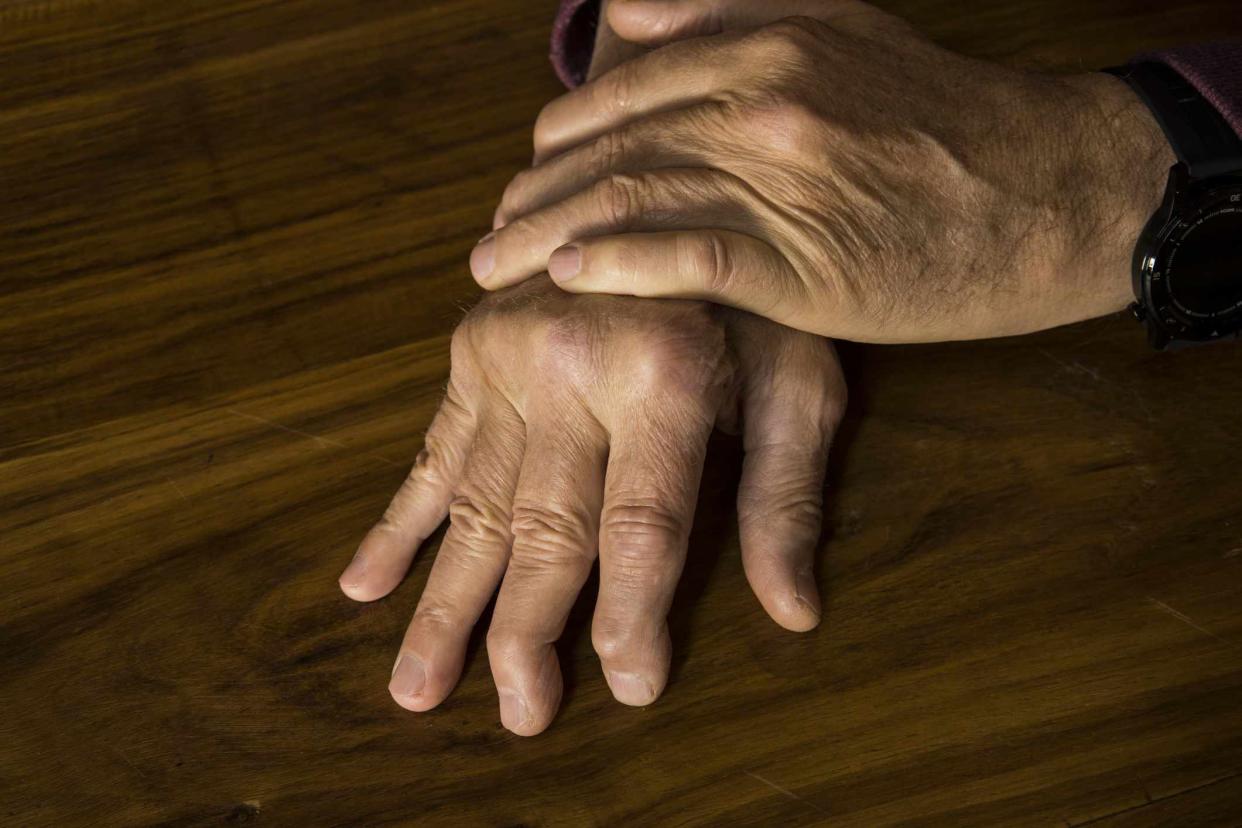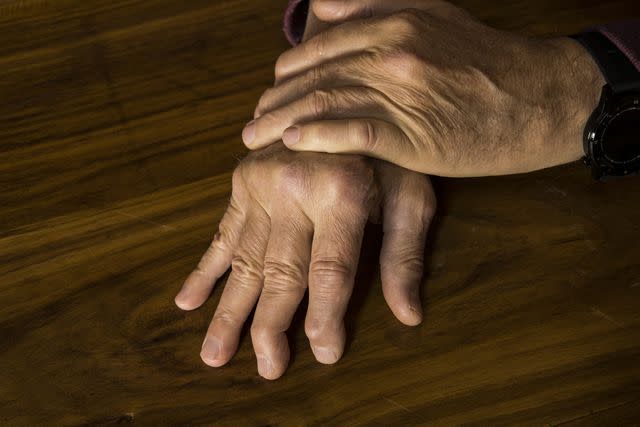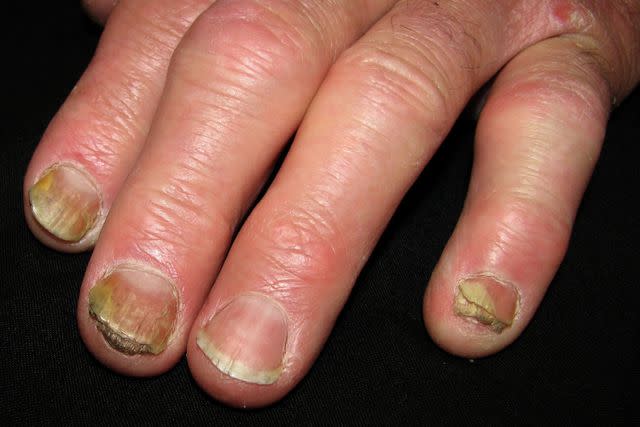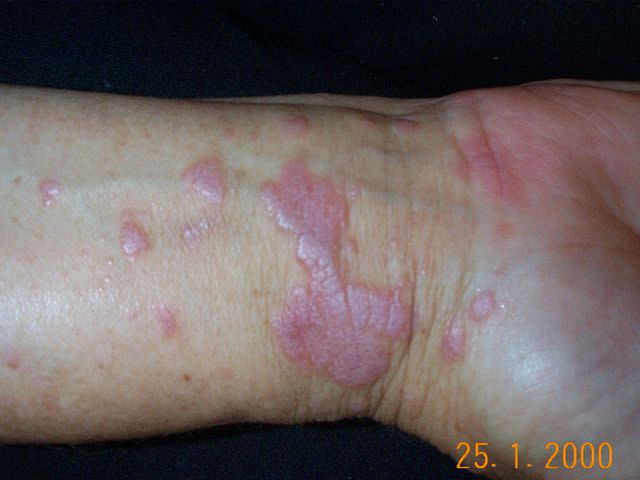What Is Psoriatic Arthritis?

Jacques Hugo / Getty Images
Psoriatic arthritis (PsA) is a progressive inflammatory disease that affects the joints and entheses, the areas where tendons and ligaments attach to bones. PsA occurs because the immune system malfunctions and starts affecting healthy tissues. Many people with PsA also have psoriasis, an autoimmune skin condition that causes skin cell overgrowth.
There is no cure for PsA, but the condition is treatable, and treatments can slow disease progression, improve pain and other symptoms, and prevent joint damage.
This article covers psoriatic arthritis symptoms, types, causes, flares, treatment, and more.

Jacques Hugo / Getty Images
Psoriatic Arthritis Symptoms
The symptoms of PsA range from mild to severe. PsA primarily affects the peripheral joints (the joints located in the arms and legs), but it can also affect the axial skeleton, which includes the spine, hips, and shoulders.
Symptoms of PsA can affect the joints, entheses, nails, and skin and may include the following:
Joint swelling, stiffness, pain, and warmth: Inflammation can cause painful joint swelling. Joints might be warm to the touch. Stiffness may be worse in the morning or after being inactive.
Low-back pain: According to one 2020 report, 25% to 70% of people with PsA have axial involvement resulting in low-back pain.
Dactylitis: Sometimes called sausage digits, dactylitis causes fingers or toes to be so swollen they look like small sausages.
Nail problems: PsA can cause the fingernails and toenails to become pitted, separated, or discolored. Nail symptoms are uncommon in other forms of inflammatory arthritis.
Eye inflammation: Some people with PsA may also experience eye problems due to the same inflammatory processes that affect the joints. Eye symptoms include redness, irritation, and blurry vision.
Foot pain: Two common areas in the foot that PsA affects are the plantar fascia along the bottom of the foot and at the Achilles tendon, which is located between the calf muscle and heel.
Fatigue: One study reported in 2021 in the International Journal of Rheumatic Diseases found fatigue was very common in PsA. That study also found severe fatigue was associated with more tender and swollen joints, dactylitis, pain, and general declining health perception.
Skin symptoms: The inflammatory processes in PsA and psoriasis can cause raised patches of itchy skin covered in silvery scales.
Psoriatic Arthritis Pictures

Reproduced with permission from ©DermNet NZ www.dermnetnz.org 2022

Reproduced with permission from ©DermNet NZ www.dermnetnz.org 2023
Types of Psoriatic Arthritis
There are five types of psoriatic arthritis. It is possible to have more than one of the following types:
Asymmetric oligoarticular: This type of PsA affects five or fewer joints. It is called asymmetric because it affects one side of the body. For example, it may affect one knee or wrist and not affect the other knee or wrist. According to a 2013 report, asymmetric oligoarticular accounts for 70% of all PsA cases. Asymmetric oligoarticular PsA may progress to symmetric polyarthritis PsA.
Symmetric polyarthritis: Symmetric polyarthritis PsA affects the same joints on both sides of your body. This means if one knee is affected, the other will be as well. The symmetric type is seen in 50% to 60% of people with PsA polyarthritis. Symmetric polyarthritis PsA is sometimes confused with rheumatoid arthritis (RA)—a different kind of inflammatory arthritis. RA typically does not cause inflammation of the entheses.
Distal interphalangeal predominant (DIP): DIP PsA affects the small joints of the fingers and toes closest to the nails. It affects about 5% of people with PsA and causes nail symptoms (pitting, splitting, separation, etc.).
Psoriatic spondylitis: This type of PsA causes inflammation in the small bones of the spine and the sacroiliac joints (located in the pelvis and lower spine). It affects 5% of people with PsA.
Arthritis mutilans: Around 5% of people with PsA have this very aggressive type of PsA. It can lead to severe bone loss and often involves the hands, feet, fingers, and wrists.
What Causes Psoriatic Arthritis?
PsA prevalence in the United States ranges from 0.06% to 0.25% of the population. While it has a low prevalence in the general population, it is common among people with psoriasis.
PsA occurs when the immune system malfunctions and attacks healthy tissues. The overactive immune responses cause inflammation of the joints and entheses. It might also cause the overproduction of skin cells.
Genetic and environmental factors in PsA are believed to trigger the immune system’s overactive response. Many people with PsA have a family history of psoriasis or PsA or a personal history of psoriasis.
PsA is also associated with specific genetic markers that, with environmental factors, can cause the disease to develop. Such factors include smoking, certain medications, physical trauma, illness, or infection.
Risk Factors for PsA
Risk factors that might increase your risk of developing PsA include:
A personal history of psoriasis: Having psoriasis is the most significant risk factor for PsA. Up to 30% of people with psoriasis will develop PsA within 10 years after psoriasis symptoms start.
Family history: Many people who get PsA have a family history of the disease, often a sibling or parent.
Age: Anyone can develop PsA, but it most often surfaces in middle age.
What Triggers PsA Flare-Ups?
PsA is characterized by flare-ups (worsening symptoms) and periods of remission (few or no symptoms). Triggers typically cause flare-ups.
PsA triggers can vary from person to person. Common triggers include:
Mental and physical stress
An injury or illness
Certain medications
Not making your medications as prescribed, including missing doses
Smoking
Having a poor diet
Overconsumption of alcohol
How Is Psoriatic Arthritis Diagnosed?
An accurate and timely diagnosis of PsA can help you to avoid joint damage and other disease complications.
No single test can confirm PsA, but your healthcare provider can make a diagnosis based on the following:
Your symptoms
Family history of PsA or psoriasis or personal history of psoriasis
A physical exam
Blood work
Imaging
Related:Psoriatic Arthritis Differential Diagnosis: Diseases That Mimic PsA
Stages of Psoriatic Arthritis
PsA is a disease that progresses over time. Progression varies from person to person.
Early Stages
Signs and symptoms may differ from what you would see with long-established PsA and will change over time.
In its early stages, PsA causes pain and swelling in a few joints, often on one side of the body. It will cause inflammation of the smaller joints of the hands and feet, usually the fingers and toes. Most people with early PsA will experience nail and skin symptoms, while around 10% will not.
As the disease progresses, you will notice symptoms in larger joints, including the knees. Over time, you may experience dactylitis and enthesitis.
Later Stages
As PsA progresses, it may affect your daily life. You might experience severe fatigue and frequent and painful flares.
Severe PsA can cause permanent damage to bones and joints. Ongoing inflammation, which might be the case for people with severe PsA, can cause bone erosion and narrowing joint space.
Living with more severe symptoms of PsA can make working or maintaining a social life harder. These symptoms can also lead to depression, and research shows the prevalence of depression is significantly higher for people with PsA than for the general population.
Psoriatic Arthritis Treatment
PsA is treated with a combination of medication, therapies, lifestyle changes, and, as a last result, surgery.
Medication
Different classes of drugs used to treat PsA include:
Nonsteroidal anti-inflammatory drugs (NSAIDs) manage joint symptoms, including pain and swelling. NSAIDs are available over the counter (OTC), or your healthcare provider can prescribe a more potent NSAID if needed.
Disease-modifying antirheumatic drugs (DMARDs) target the immune system to slow down its effects. The most commonly used DMARD is methotrexate.
Biologics target specific inflammatory proteins in the immune system that cause inflammation. These drugs are available as injections you can do at home or as intravenous (IV) infusions given at a hospital or clinic.
Janus kinase (JAK) inhibitors block specific pathways and processes that cause inflammation.
Topical creams and ointments manage skin symptoms of PsA and psoriasis. Some are available OTC, while your healthcare provider can prescribe others.
Therapies
Many people with PsA can benefit from physical and occupational therapies to manage joint symptoms. Your healthcare provider might prescribe light therapy if you experience skin symptoms of the disease.
If you are experiencing depression or anxiety, your healthcare provider might recommend mental health therapy options to help you better cope with the effects of PsA.
Related:Physical Therapy for Psoriatic Arthritis
Surgery
Surgery is a last resort for people with PsA. It is often recommended for people who experience severe pain due to a damaged joint. Surgery aims to improve joint function, reduce pain, and prevent additional joint damage.
Related:Everything You Need to Know About Psoriatic Arthritis Surgery
Lifestyle Changes
As part of your treatment plan, your healthcare provider might recommend lifestyle changes to help you better manage PsA.
Lifestyle changes that might better help manage PsA include:
Being active: Regular, low-impact exercise, such as yoga, walking, or swimming, can help keep your joints strong and flexible.
Practicing stress management techniques: Stress management techniques can include meditation, deep breathing, and yoga.
Not smoking: Smoking can increase inflammation in the body. If you need help quitting, let your healthcare provider know. They can provide you with information and resources to help you quit.
Maintaining a healthy weight: Excess weight places stress on joints so it helps to be at a healthy weight.
Related:Smoking Cessation: How to Quit and What to Expect
Diet for Psoriatic Arthritis
There is no specific diet for PsA, but eating a healthy and nutritious diet can help to control inflammation and relieve PsA symptoms.
Some foods might increase inflammation, while others might help reduce it. Foods that cause inflammation might include sugars, fried foods, refined carbs, red meats, and alcohol. Foods that might reduce inflammation include fatty fish, nuts, olive oil, leafy green vegetables, and some fruits.
Complications of Psoriatic Arthritis
If PsA is not adequately treated, it can lead to complications.
Complications and comorbidities linked to PsA include:
Joint and bone damage
Diabetes
Serious, life-threatening infections
Gout (a type of inflammatory arthritis)
Osteoporosis (weak and brittle bones)
Depression
Inflammatory bowel disease (IBD) (includes Crohn's disease and ulcerative colitis)
Vision problems
Arthritis mutilans (rare advanced joint disease)
Related:What You Need to Know About Comorbidities in Psoriatic Arthritis
Outlook for Psoriatic Arthritis
The outlook for PsA varies from person to person. For some people, PsA causes mild disease and a few flare-ups a year. PsA can be painful for others, leading to disability and severe joint damage.
Fortunately, PsA can be managed with appropriate treatment, and most people with the condition can manage pain and will not experience significant joint damage or disease complications.
Let your healthcare provider know if you have questions or concerns about your outlook. They can advise on ways to improve your outlook and the best ways to manage your disease.

